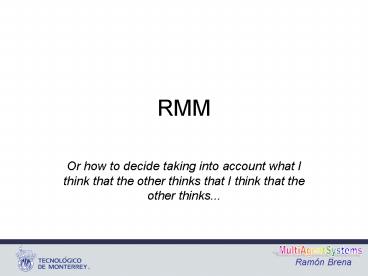RMM - PowerPoint PPT Presentation
1 / 20
Title:
RMM
Description:
Example.- Observation Robots. Ram n Brena. MultiAgentSystems. Possible actions ... .but R2 needs to know what R1 thinks in order to make a rational decision. ... – PowerPoint PPT presentation
Number of Views:155
Avg rating:3.0/5.0
Title: RMM
1
RMM
- Or how to decide taking into account what I think
that the other thinks that I think that the other
thinks...
2
Multiagent Rational Decisions
- Without other rational agents
- With other rational agents
- Game Theory equilibria
- Recursive Decision Analysis
3
Utility matrices
4
Example.- Observation Robots
5
Possible actions
- a11 R1 goes to P1
- a12 R1 goes to P2
- a13 R1 does nothing
- a21 R2 goes to P1
- a22 R2 goes to P2
- a23 R2 does nothing
6
Utility matrix calculation
7
Utility matrix calculation
8
What will R2 do?Case 1.- R2 knows about P2
9
What will R2 do?Case 1.- R2 knows about P2
10
Case 2.- R2 does not know about P2
11
Case 2.- R2 does not know about P2
12
Probabilities
P0.9
P0.1
13
Model nesting
- ...but R2 needs to know what R1 thinks in order
to make a rational decision. - This could continue indefinitely
- At some point recursive mutual knowledge ends.
- No-info nodes
14
(No Transcript)
15
No-infos
- No-info2 indicates that R1 knows R2 does not have
knowledge to model R1 - No-info1 represents lack of knowledge in R1 about
whether it is being modeled by R2 or how. - No-info could be considered as a uniform
probability distribution over actions.
16
Solving the decision problem
- We proceed bottom-up
- First we calculate the expected utility of
subtrees, then the utility of nodes. - Process ends when root is reached.
17
Leaves calculation
- If R2 does not know about P2, R2 expected
utilities are - u(a21) 0.50 0.50 0
- u(a23) 0.52 0.50 1 (wins)
- If R2 could see P2, its utilities are
- u(a21) 0.330 0.334 0.330 1.33
- u(a22) 0.335 0.333 0.333 3.67 (wins)
- u(a23) 0.332 0.334 0.330 2
18
Reconsidering R2
- With probability p 0.9 decides a23 (do
nothing) - With probability p 0.1 decides a22 (go to P2)
- So with probability p 0 decides a21 (go to P1)
19
Upwards propagation
- Utilities of R1 actions are
- u(a11) 01 0.15 0.91 1.4
- u(a12) 04 0.12 0.92 2
- u(a13) 02 0.14 0.90 0.4
- We conclude that R1 decides to go to P2
- R1 believes it is so unlikely that R2 goes to P2,
that it better goes itself.
20
Comparison with Game Theory
- Game Theory equilibria search does not apply
because there is no common knowledge - (R1 does not know if R2 knows what R1 knows about
P2, etc).

